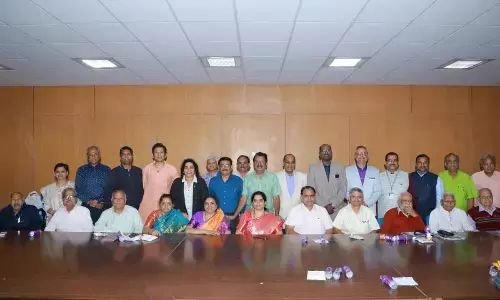Reviving ancient Bharat’s musical Instruments

In an increasingly globalised world, the future of ancient instruments, such as the sitar and tabla, appears to hinge on their integration within contemporary musical practices.
In an increasingly globalised world, the future of ancient instruments, such as the sitar and tabla, appears to hinge on their integration within contemporary musical practices. While traditional forms are often relegated to the margins, the cross-pollination of genres presents an opportunity for these instruments to reclaim their relevance. Collaborations between classical musicians and artists from diverse genres, including jazz and electronic, can lead to innovative fusions that resonate with younger audiences. Additionally, the rising interest in world music has fostered a growing appreciation for the rich cultural heritage embodied in these instruments, prompting artists to experiment with their sounds and techniques. This revitalisation is not merely an aesthetic endeavor; it reflects a broader societal recognition of cultural identity and heritage, advocating for the preservation of traditional arts in a modern context.
Padma Shri Darshanam Mogulaiah’s Kinnera was revived and preserved reverberating echoes of ancient civilisations. The musical traditions resonate offering insights that transcend mere entertainment. In the context of Bharat, the unique cultural history is intricately woven with the sounds of traditional instruments that have shaped spiritual identity. As modernity encroaches upon these age-old practices, the revival of ancient Indian instruments serves not only to preserve a significant aspect of cultural heritage but also to re-establish connections to the past. The critical importance of reviving these instruments, examining their historical significance and the role they can play in contemporary society needs to be discussed.
The instruments Rudra veena and Sarangi, highlighting their artistic expression, philosophical and cultural narratives, and unique stories. It highlights the importance of preserving these instruments for cultural continuity and diversity, promoting diversity in a homogenizing world. The preservation of these musical forms enriches contemporary experiences, blending past and present.
Instruments, such as the sitar, veena, and tabla, have become integral parts of Indian culture, transcending mere musicality to embody philosophical and theological ideals. These instruments are celebrated for their sonic qualities and ability to evoke emotional states, facilitating spiritual connection. In religious contexts, they are often linked to rituals and performances, serving as conduits for divine communication and enlightenment. Classical music traditions, like Hindustani and Carnatic, showcase the innate sophistication of these instruments, allowing for nuanced expressions reflecting complex emotional landscapes. These instruments continue to hold significant cultural weight, symbolizing a rich heritage that fosters continuity and innovation within society.
Importance of Reviving Ancient Instruments
In the intricate tapestry of Indian cultural heritage, ancient instruments serve not merely as relics of the past but as vital expressions of identity and artistic narrative. The revival of these instruments fosters a deeper connection to the roots, rediscovering musical traditions that encapsulate the cultural dialogues across regions. For instance, the resurgence of the rudra veena and the pakhawaj has reinvigorated classical music scenes, attracting both established musicians and budding artists who seek to explore their roots. This revival extends beyond mere performance; it ignites scholarly discourse on the acoustics, construction techniques, and the historical contexts of these instruments, thereby enriching musicology and performance studies.
The revival of ancient instruments in a globalised world counters homogenized music experiences, re-establishing India’s cultural narratives. By weaving indigenous sounds into contemporary compositions, musicians bridge generations and cultures, enhancing appreciation and relevance. This preservation of cultural heritage fosters a nuanced understanding of identity. Investing in educational initiatives empowers future generations to honor and sustain this legacy, promoting a diverse and inclusive cultural dialogue.
Preservation of Cultural Heritage and Identity
The revival of ancient Indian instruments, such as the rudra veena and pungi, is crucial for safeguarding cultural heritage and reaffirming community identity. These instruments embody historical contexts, philosophies, and aesthetic values, fostering a deeper understanding of India’s identity. Engaging contemporary musicians and artisans ensures the skills and knowledge of these instruments evolve while remaining rooted in their original contexts.
Among the instruments that have witnessed revitalisation is the Rudra veena, an instrument once esteemed in classical performances yet gradually overshadowed by more contemporary counterparts. The efforts of musicians like Umayalpuram K Sivaraman have not only brought this two-headed string instrument back into the limelight but also sparked interest in its unique tonal qualities and construction techniques. Similarly, the revival of the Mohan veena, popularised by virtuosos such as Pandit Vishwa Mohan Bhatt, highlights the fusion of traditional practice with modern innovations, encouraging a broader appreciation among diverse audiences. Pt. Joydeep Mukherjee was credited to revive Tanseni Rabab and Sur Rabab from the 18 th and the 19 th century. These illuminate the intertwining of historical artistry with contemporary musical expression, forging connections that transcend time. Such revivals are vital not merely for cultural preservation but also for fostering a dynamic dialogue within and beyond Indias musical landscape, ensuring that these ancient instruments continue to resonate with future generations.
Instruments, such as the bamboo flute and the tabla, have been revitalised and integrated into contemporary music. The bansuri, a classical instrument, has evolved into a versatile tool in fusion and electronic music. The tabla has also been adapted to global music genres, showcasing how ancient instruments can transcend their original contexts.



















